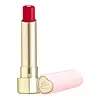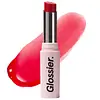What's inside
What's inside
 Key Ingredients
Key Ingredients

 Benefits
Benefits

 Concerns
Concerns

 Ingredients Side-by-side
Ingredients Side-by-side

Polyglyceryl-2 Triisostearate
EmulsifyingDiisostearyl Malate
EmollientHydrogenated Poly(C6-14 Olefin)
EmollientPolybutene
Pentaerythrityl Tetraisostearate
EmollientBis-Diglyceryl Polyacyladipate-2
EmollientPolyethylene
AbrasiveOctyldodecanol
EmollientSynthetic Fluorphlogopite
Synthetic Wax
AbrasiveMalpighia Glabra Fruit Extract
Skin ConditioningEuphorbia Cerifera Wax
Caprylic/Capric Triglyceride
MaskingIsohexadecane
EmollientButyrospermum Parkii Butter
Skin ConditioningSodium Hyaluronate
HumectantTripeptide-1
Skin ConditioningDisteardimonium Hectorite
StabilisingPropylene Carbonate
SolventEthylene/Propylene Copolymer
AbrasiveEthylene/Propylene/Styrene Copolymer
Butylene/Ethylene/Styrene Copolymer
Xanthan Gum
EmulsifyingPolyhydroxystearic Acid
EmulsifyingCaprylyl Glycol
EmollientHexylene Glycol
EmulsifyingParfum
MaskingPentaerythrityl Tetra-Di-T-Butyl Hydroxyhydrocinnamate
AntioxidantPhenoxyethanol
PreservativeCI 77891
Cosmetic ColorantCI 77491
Cosmetic ColorantCI 77492
Cosmetic ColorantCI 77499
Cosmetic ColorantCI 42090
Cosmetic ColorantCI 15850
Cosmetic ColorantCI 45410
Cosmetic ColorantCI 73360
Cosmetic ColorantCI 19140
Cosmetic ColorantPolyglyceryl-2 Triisostearate, Diisostearyl Malate, Hydrogenated Poly(C6-14 Olefin), Polybutene, Pentaerythrityl Tetraisostearate, Bis-Diglyceryl Polyacyladipate-2, Polyethylene, Octyldodecanol, Synthetic Fluorphlogopite, Synthetic Wax, Malpighia Glabra Fruit Extract, Euphorbia Cerifera Wax, Caprylic/Capric Triglyceride, Isohexadecane, Butyrospermum Parkii Butter, Sodium Hyaluronate, Tripeptide-1, Disteardimonium Hectorite, Propylene Carbonate, Ethylene/Propylene Copolymer, Ethylene/Propylene/Styrene Copolymer, Butylene/Ethylene/Styrene Copolymer, Xanthan Gum, Polyhydroxystearic Acid, Caprylyl Glycol, Hexylene Glycol, Parfum, Pentaerythrityl Tetra-Di-T-Butyl Hydroxyhydrocinnamate, Phenoxyethanol, CI 77891, CI 77491, CI 77492, CI 77499, CI 42090, CI 15850, CI 45410, CI 73360, CI 19140
Polybutene
Bis-Behenyl/Isostearyl/Phytosteryl Dimer Dilinoleyl Dimer Dilinoleate
EmollientSimmondsia Chinensis Seed Oil
EmollientDiisostearyl Malate
EmollientPolyethylene
AbrasiveTriisostearyl Citrate
EmollientC12-15 Alkyl Lactate
EmollientEuphorbia Cerifera Wax
Pentaerythrityl Tetraisostearate
EmollientTrimethylolpropane Triisostearate
EmollientLimnanthes Alba Seed Oil
Skin ConditioningOctyldodecanol
EmollientTridecyl Trimellitate
EmollientSucrose Acetate Isobutyrate
Synthetic Fluorphlogopite
Sodium Hyaluronate
HumectantHelianthus Annuus Seed Wax
Skin ConditioningCitrullus Lanatus Seed Oil
EmollientTribehenin
EmollientRicinus Communis Seed Oil
MaskingTocopheryl Acetate
AntioxidantButyrospermum Parkii Nut Extract
EmollientHydrated Silica
AbrasiveLecithin
EmollientEthylhexyl Palmitate
EmollientCaprylic/Capric Triglyceride
MaskingPalmitoyl Tripeptide-1
Skin ConditioningLactic Acid
BufferingAscorbyl Palmitate
AntioxidantPentaerythrityl Tetra-Di-T-Butyl Hydroxyhydrocinnamate
AntioxidantTocopherol
AntioxidantSorbitan Oleate
EmulsifyingSorbitan Isostearate
EmulsifyingCaprylyl Glycol
EmollientCI 15850
Cosmetic ColorantTitanium Dioxide
Cosmetic ColorantIron Oxides
CI 42090
Cosmetic ColorantCI 45410
Cosmetic ColorantCI 19140
Cosmetic ColorantCI 15985
Cosmetic ColorantPolybutene, Bis-Behenyl/Isostearyl/Phytosteryl Dimer Dilinoleyl Dimer Dilinoleate, Simmondsia Chinensis Seed Oil, Diisostearyl Malate, Polyethylene, Triisostearyl Citrate, C12-15 Alkyl Lactate, Euphorbia Cerifera Wax, Pentaerythrityl Tetraisostearate, Trimethylolpropane Triisostearate, Limnanthes Alba Seed Oil, Octyldodecanol, Tridecyl Trimellitate, Sucrose Acetate Isobutyrate, Synthetic Fluorphlogopite, Sodium Hyaluronate, Helianthus Annuus Seed Wax, Citrullus Lanatus Seed Oil, Tribehenin, Ricinus Communis Seed Oil, Tocopheryl Acetate, Butyrospermum Parkii Nut Extract, Hydrated Silica, Lecithin, Ethylhexyl Palmitate, Caprylic/Capric Triglyceride, Palmitoyl Tripeptide-1, Lactic Acid, Ascorbyl Palmitate, Pentaerythrityl Tetra-Di-T-Butyl Hydroxyhydrocinnamate, Tocopherol, Sorbitan Oleate, Sorbitan Isostearate, Caprylyl Glycol, CI 15850, Titanium Dioxide, Iron Oxides, CI 42090, CI 45410, CI 19140, CI 15985
 Reviews
Reviews

Ingredients Explained
These ingredients are found in both products.
Ingredients higher up in an ingredient list are typically present in a larger amount.
This ingredient is an emollient, solvent, and texture enhancer. It is considered a skin-softener by helping the skin prevent moisture loss.
It helps thicken a product's formula and makes it easier to spread by dissolving clumping compounds.
Caprylic Triglyceride is made by combining glycerin with coconut oil, forming a clear liquid.
While there is an assumption Caprylic Triglyceride can clog pores due to it being derived from coconut oil, there is no research supporting this.
Learn more about Caprylic/Capric TriglycerideCaprylyl Glycol is a humectant and emollient, meaning it attracts and preserves moisture.
It is a common ingredient in many products, especially those designed to hydrate skin. The primary benefits are retaining moisture, skin softening, and promoting a healthy skin barrier.
Though Caprylyl Glycol is an alcohol derived from fatty acids, it is not the kind that can dry out skin.
This ingredient is also used as a preservative to extend the life of products. It has slight antimicrobial properties.
Learn more about Caprylyl GlycolCi 15850 is the pigment color red. It is an azo dye and created synthetically.
Azo dyes need to be thoroughly purified before use. This allows them to be more stable and longer-lasting.
This ingredient is common in foundations, lipsticks, and blushes. This color is described as brown/orangey red.
It has many secondary names such as Red 6 and Red 7. According to a manufacturer, Red 6 usually contains aluminum.
Learn more about CI 15850CI 19140 is also known as Tartrazine. Tartrazine is a synthetic dye used in cosmetics, foods, and medicine to add a yellow color.
Tartrazine is created from petroleum and is water-soluble.
Some people may experience allergies from this dye, especially asthmatics and those with an aspirin intolerance.
Learn more about CI 19140Ci 42090 is a synthetic dye created from petroleum. It is used to give a bright blue color to cosmetics, medicine, and food.
CI 45410 is a synthetic red-pigment and dye.
It often goes by both Red 28 or Red 27; manufacturers label both ingredients as CI 45410.
This dye is commonly found in makeup because it imparts a vivid color. Some types of this dye change color based on pH level and interaction with moisture:
Your skin has a natural pH of around 4.5 - 5.5.
According to the FDA, CI 45410 is not permitted for use in eye products.
Red 27 is a flourescein dye and commonly used as a fluorescent tracer in medicine.
Learn more about CI 45410Diisostearyl Malate is an emollient and most often used in lip products. It comes from isostearyl alcohol, a fatty acid, and malic acid, an AHA.
As an emollient, Diisostearyl Malate helps create a thin film on your skin to trap moisture in. This helps keep your skin soft and smooth.
Octyldodecanol is a fatty alcohol. It is primarily used to enhance the texture of products.
As an emulsifier, Octyldodecanol helps prevent the oils and waters from separating. It also prevents ingredients from creating foam when shaken.
Octyldodecanol is created by reducing fatty acid to an alcohol.
Due to its high molecular weight, it does not get absorbed into the skin.
Learn more about OctyldodecanolPentaerythrityl Tetra-Di-T-Butyl Hydroxyhydrocinnamate (long name, huh?) is a synthetic antioxidant.
It is used to help stabilize other antioxidants or prevent the color from changing in a product.
As an antioxidant, it helps fight free-radical molecules. Free-radical molecules are capable of damaging our cells and other genetic material. Thus, antioxidants may reduce the signs of aging.
This ingredient is oil-soluble.
Learn more about Pentaerythrityl Tetra-Di-T-Butyl HydroxyhydrocinnamatePentaerythrityl Tetraisostearate is derived from isostearic acid. It is an emollient and emulsifier.
The highest concentration of this ingredient is found in lipsticks.
This ingredient is minimally water soluble and may not be Malassezia folliculitis, or fungal-acne safe.
Learn more about Pentaerythrityl TetraisostearatePolybutene is used to help control the viscosity of a product. This just means it helps adjusts the texture.
It is a polymer and does not get absorbed into the skin due to its large size.
Studies found this ingredient did not irritate skin in concentrations below 15%.
Learn more about PolybutenePolyethylene is a synthetic ingredient that helps the skin retain moisture. It is a polymer.
It is also typically used within product formulations to help bind solid ingredients together and thicken oil-based ingredients. When added to balms and emulsions, it helps increase the melting point temperature.
Sodium Hyaluronate is hyaluronic acid's salt form. It is commonly derived from the sodium salt of hyaluronic acid.
Like hyaluronic acid, it is great at holding water and acts as a humectant. This makes it a great skin hydrating ingredient.
Sodium Hyaluronate is naturally occurring in our bodies and is mostly found in eye fluid and joints.
These are some other common types of Hyaluronic Acid:
Learn more about Sodium HyaluronateSynthetic Fluorphlogopite is the synthethic version of mica. It consists of fluorine, aluminum and silicate.
Synthetic Fluorphlogopite is used to add volume to products.
It is considered non-irritating on the skin.
Learn more about Synthetic FluorphlogopiteEuphorbia Cerifera wax comes from a shrub in Northern Mexico. It is used to stabilize formulations and has emollient properties.
Emollients form a thin layer on top of skin to prevent water from evaporating, keeping skin and lips hydrated.
According to a manufacturer, this wax can range from a yellow/brown color to translucent.
Learn more about Euphorbia Cerifera Wax